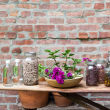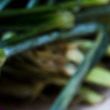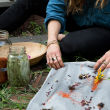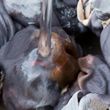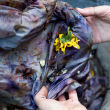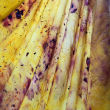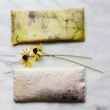Common problems often call for surprisingly low-tech solutions. So if you, like us, are all too familiar with puffy eyes that are immune to all those futuristic firming gels and lifting rollerballs, may we suggest an alternative?
Eye pillows—like the ones you may you recall from trips to fancy spas. These little cushions are filled with herbs, seeds, and extracts to help bring down swelling in the orbital area. As a bonus, they'll chill you out enough that maybe you won't even care that you have eye bags in the first place.
Brooklyn-based makeup artist Jessa Blades and natural fabric artist Cara Marie Piazza are so keen on this old-school favorite that they decided to team up and create a super holistic version, made from silk and dyed with flowers. Their technique is actually quite easy—perfect for the DIYer in search of a little fancy-shmance in their life. (Alternatively, the ready-made eye pillows drop on Blades Beauty today.)
Blades often tosses hers in a suitcase to fight under-eye bags on long-haul flights, while Piazza enjoys this winning ritual: “After a rough day, I like to light some palo santo, lie on my bed, and place the pillow over my eyes and breathe deeply.” Sold.
Part I: Dye the Silk
Materials
-Fresh flowers from the farmer's market or old bouquets before they turn brown: zinnias, dahlias, cosmos, and coreopsis transfer their color particularly well
-1 piece of square silk roughly 8.5 inches wide for the pillow (use a larger size if you want to make another project)
-Stainless steel pot with steamer basket
-Rubber bands or string
-Tongs
-Distilled white vinegar
Method
Fill your pot with water, insert the steamer basket, and cover to bring to a boil. Lay out your silk and sprinkle your flowers in a desired pattern leaving the heads whole, or pluck and scatter the petals to cover the fabric fully [photo 3]. “Wherever the flowers land on the fabric will form your print.” says Blades. Starting from one end, roll the fabric evenly, trying to keep all of the petals and botanical matter tightly packed in your bundle [4].
After you've tightly rolled the fabric, secure it with rubber bands or string. “It should resemble a sausage.” notes Blades. Dip the fabric roll into a bowl of distilled vinegar, thoroughly wetting it [5]. “Or fill a small spray bottle with the distilled vinegar and mist the fabric roll evenly all over.” offers Blades. “This helps to set the color and bring out the brighter tones of the flowers.”
Place your bundle in the steamer basket for at least one hour. “Time is of the essence with natural dyeing, so if you can leave for longer, I would highly recommend it.” advises Blades. After your steaming is complete, pick up your bundle with your tongs and rinse lightly under cold water. Then unravel the bundle over a compost heap or bowl “You can save the insides to make a later version.” says Blades). Shake off the flowers and give your silk a quick cold rinse [6].
Let the fabric dry naturally overnight. “The next day, flip over the fabric and lightly iron it to set the color.” says Blades. Done! Now onto the pillow…
Part II: Make the Pillow
Materials
-Needle and thread
-A piece of silk roughly 8.5 inches by 8.5 inches
-7 ounces of flax seeds and lavender seeds (we like a ratio 3 parts flax to 1 part lavender)
Method
'Fold your piece of silk in half, so the pattern is facing in, and sew up the sides, leaving one of the smaller sides open.” says Blades. Turn the pillow right side out to the side that you want to show. “Fill the pillow with your blend of flax and lavender seeds. Turn the edges of the open side in on themselves, then sew across, and voila! Your eye pillow is ready for you to enjoy.”
—Kari Molvar
Photographed by Nicole Franzen.









